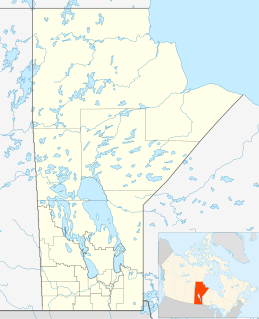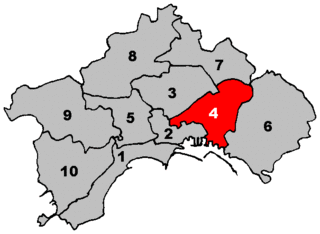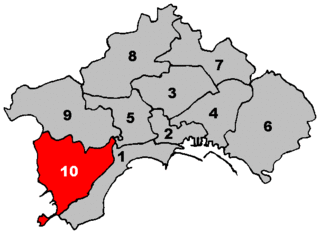
Zona Industriale (in Italian literary Industrial Zone, referring to the industrial park), is a quarter of Naples, Italy. With Poggioreale, San Lorenzo, and Vicaria it forms the Fourth Municipality of the city.

Zona Industriale (in Italian literary Industrial Zone, referring to the industrial park), is a quarter of Naples, Italy. With Poggioreale, San Lorenzo, and Vicaria it forms the Fourth Municipality of the city.
Situated in the southeastern area of the city, close to the coast, Zona Industriale borders with the quarters of Porto, Mercato, San Lorenzo, Vicaria, Poggioreale, Barra and San Giovanni a Teduccio. It covers an area of 2.68 km2 and its population is of 6,082. Most of the area is covered by factories.
Coordinates: 40°50′50″N14°17′01″E / 40.84722°N 14.28361°E

Mystery Lake is a local government district (LGD) in northern Manitoba. It surrounds the city of Thompson, although most of its territory lies to the southwest and south of the city. It is named after Mystery Lake, a lake located in the northeast section of the LGD, northeast of Thompson.

The University of Naples Federico II is a public university in Naples, Italy. Founded in 1224, it is the oldest public non-sectarian university in the world, and is now organized into 26 departments. It was Europe's first university dedicated to training secular administrative staff, and is one of the oldest academic institutions in continuous operation. Federico II is the third University in Italy by number of students enrolled, but despite its size it is still one of the best universities in Italy and the world, being particularly notable for research; in 2015 it was ranked among the top 100 universities in the world by citations per paper. The university is named after its founder Frederick II. In October 2016 the University hosted the first ever Apple IOS Developer Academy and in 2018 the Cisco Digital Transformation Lab.
The Naples Conservatory of Music is a music school located in Naples, Italy. It is situated in the complex of San Pietro a Majella.

Castel Capuano is a castle in Naples, southern Italy. It takes its name from the fact that it was at that point in the city walls where the road led out to the city of Capua. The castle is at the southwest end of via dei Tribunali, and until recently housed the Naples Hall of Justice, which has now moved to the new Civic Center, the Centro Direzionale.

The Centro direzionale is a business district in Naples, Italy, close to the station of Napoli Centrale, they constitute an entire citadel. Designed by the Japanese architect Kenzō Tange, the entire complex was completed in 1995. It is the first cluster of skyscrapers to have been built in Italy and southern Europe.

During World War II the Italian city of Naples suffered approximately 200 air raids by the Allies from 1940 to 1944; only Milan was attacked more frequently. Almost all of the attacks — a total of 181 — were launched in the first nine months of 1943 before the Four days of Naples and the Allied occupation of the city at the beginning of October. Estimates of civilian casualties vary between 20,000 and 25,000 killed.
Porto is one of the thirty quarters ("quartieri") of the city of Naples. It covers 1.14 square kilometres (0.44 sq mi), and as of 2009, had 5738 inhabitants.

San Lorenzo is a district of Naples, Italy. It incorporates the precise geographical center of the ancient Greco-Roman city, centered on the intersection of Via San Gregorio Armeno and Via dei Tribunali.

Pendino is one of the 30 quartieri of Naples, southern Italy.

Vicaria, often known as Il Vasto, is one of the 30 quartieri of Naples, southern Italy, lying immediately to the east of the historical city centre.

Poggioreale is a neighbourhood of Naples, southern Italy. It is at the extreme east end of the downtown Naples and includes the central train station, Naples Civic Center, Poggioreale prison, and the industrial area to the east.

The districts of Naples are the sectors that, within the city, are identified by particular geographical and topographical, functional and historical features.

The Fourth Municipality is one of the ten boroughs in which the Italian city of Naples is divided.

The Fifth Municipality is one of the ten boroughs in which the Italian city of Naples is divided. It is the most populated municipality.

The Sixth Municipality is one of the ten boroughs in which the Italian city of Naples is divided. It is the largest municipality in the city by surface area.

The Tenth Municipality is one of the ten boroughs in which the Italian city of Naples is divided.

The historic center of Naples represents the first historical nucleus of the city. It contains 27 centuries of history.

Arenaccia is a historical neighborhood or zona of the Fourth Municipality of northeastern Naples, Italy. Its name derives from the Via Arenaccia road that divides the neighborhoods of San Lorenzo and Vicaria, which covers the area. The east–west boundaries are represented roughly by the Piazza Carlo III and the Corso Malta, while the north-west boundaries are represented from the beginning and end of the Via Arenaccia.

The Cemetery of Poggioreale is one of the major cemeteries in Naples, Italy. It is also known as Camposanto Nuovo, to distinguish it from Camposanto Vecchio, which is now known as Cemetery of the 366 Fossae. It is delimited by the Largo Santa Maria del Pianto, Via del Riposo, Via Santa Maria del Pianto, and via nuova Poggioreale, and is built upon the ruins of Alphonso II's Villa Poggio Reale.

The Poggio Reale villa or Villa Poggio Reale was an Italian Renaissance villa commissioned in 1487 by Alfonso II of Naples as a royal summer residence. The Italian phrase "poggio reale" translates to "royal hill" in English. The villa was designed and built by Giuliano da Maiano and located in the city of Naples, in the district now known as Poggioreale, between the present Via del Campo, Via Santa Maria del Pianto and the new and old Via Poggioreale. At the time it was built, a period when the capital city of the Kingdom of Naples was renowned for elegant homes with expansive vistas of the surrounding landscape and Mount Vesuvius, the villa was outside the city walls of Naples and was one of the most important architectural achievements of the Neapolitan Renaissance. Imitated, admired, robbed of its treasures by another king, left in ruins and partially destroyed, the summer palace of the King of Naples lives on in name as a style.